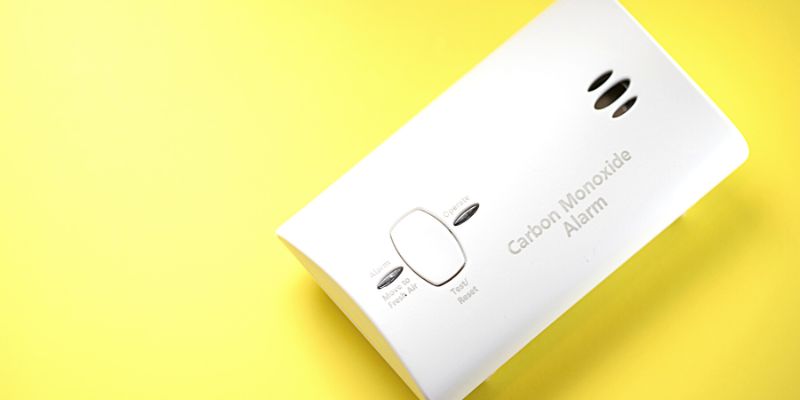Traveling is an exciting adventure, but it’s crucial to prioritize safety amidst anticipation and exploration. One often overlooked danger is carbon monoxide (CO), an odorless and colorless gas that can be life-threatening.
In this blog post, we will explore the significance of carbon monoxide detectors for travelers, helping you stay safe during your journeys.
Let’s get into it!
Table of Contents
Understanding Carbon Monoxide

Before delving into the importance of carbon monoxide detectors, let’s understand the gas itself. Carbon monoxide is produced by incomplete combustion of gas, oil, coal, and wood. It can accumulate in enclosed spaces, posing serious health risks.
Exposure to carbon monoxide can lead to symptoms like headaches, dizziness, nausea, confusion, and, in severe cases, even death.
Carbon Monoxide Detectors: An Essential Travel Companion
Carbon monoxide detectors are your first line of defense against this silent threat. These devices are specifically designed to detect the presence of carbon monoxide in the air and emit an alarm when levels become hazardous at home.
You may already have a carbon monoxide detector installed, but their importance multiplies when you travel.
Increased exposure risks during travel
Whether you’re staying in hotels, vacation rentals, or even camping, you may encounter unfamiliar heating systems, gas appliances, or other potential sources of carbon monoxide. Carbon monoxide detectors can help you identify these dangers and take necessary precautions.
Variability of accommodation standards
Accommodation standards can vary widely, especially in different countries or remote locations. A carbon monoxide detector provides additional protection, even in places where regulations and safety standards may be less stringent.
Common sources of carbon monoxide during travel
Travel often involves using vehicles like cars, RVs, boats, or airplanes. These vehicles may have their potential sources of carbon monoxide, such as exhaust leaks or faulty heating systems. Carrying a portable carbon monoxide detector can help detect these dangers on the go.
Choosing the Right Carbon Monoxide Detector for Travel
When selecting a carbon monoxide detector for travel, there are a few factors to consider:
- Portable carbon monoxide detectors: Opt for battery-operated detectors or plug-in detectors with battery backup, ensuring they can function regardless of the availability of power sources.
- Size and portability: Choose a compact, lightweight detector that easily fits your luggage or travel bag. Portable detectors are designed for travel convenience.
- Sensitivity and alarm features: Look for detectors with high sensitivity to detect low levels of carbon monoxide and loud alarms that can wake you up even in a noisy environment.
Tips for Traveling with a Carbon Monoxide Detector
To make the most of your carbon monoxide detector while traveling, keep these tips in mind:
- Pack and store the detector properly: Ensure the detector is securely packed to avoid damage during travel. Keep it easily accessible for immediate use when needed.
- Proper placement in accommodations: Place the detector in the sleeping area of your accommodation, near potential sources of carbon monoxide such as gas appliances or heaters. Follow the manufacturer’s instructions for optimal placement.
- Regular testing and maintenance while on the go: Test the detector regularly to ensure it’s functioning correctly. Replace batteries if the detector malfunctions; seek a replacement or repair immediately.
Staying Safe from Carbon Monoxide during Travel
In addition to using carbon monoxide detectors, here are a few precautions to minimize your exposure risks:
- Recognizing potential sources of carbon monoxide: Learn to identify common sources, such as gas-powered generators, charcoal grills, or faulty heating systems. Stay vigilant and report any concerns to the accommodation staff.
- Precautions to minimize exposure risks: Ensure proper ventilation in enclosed spaces and never use fuel-burning appliances or heaters in closed environments. If using a fireplace, make sure the chimney is functioning correctly.
- Emergency response and evacuation procedures: Familiarize yourself with emergency protocols and procedures specific to your accommodation or mode of transportation. Being prepared can make a significant difference in critical situations.
Conclusion
Regarding travel, your safety should always be a top priority. Carbon monoxide detectors act as crucial companions during your journeys, alerting you to potential dangers and helping you take appropriate measures.
You can enjoy your travels with peace of mind by choosing the right detector, following proper placement and maintenance, and staying informed about carbon monoxide risks.
Remember, an ounce of prevention is worth a pound of cure for carbon monoxide safety.
Safe travels!










